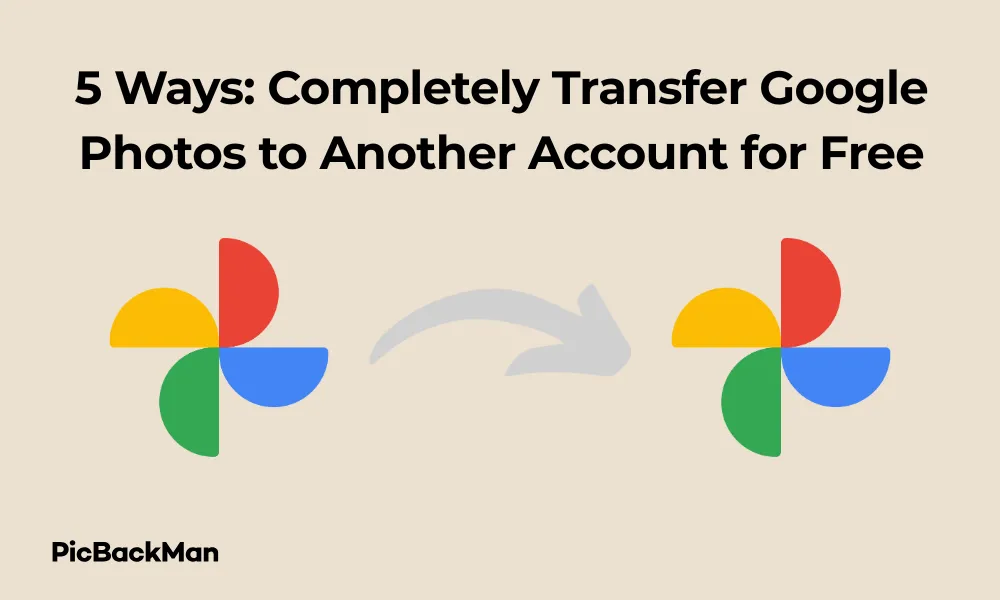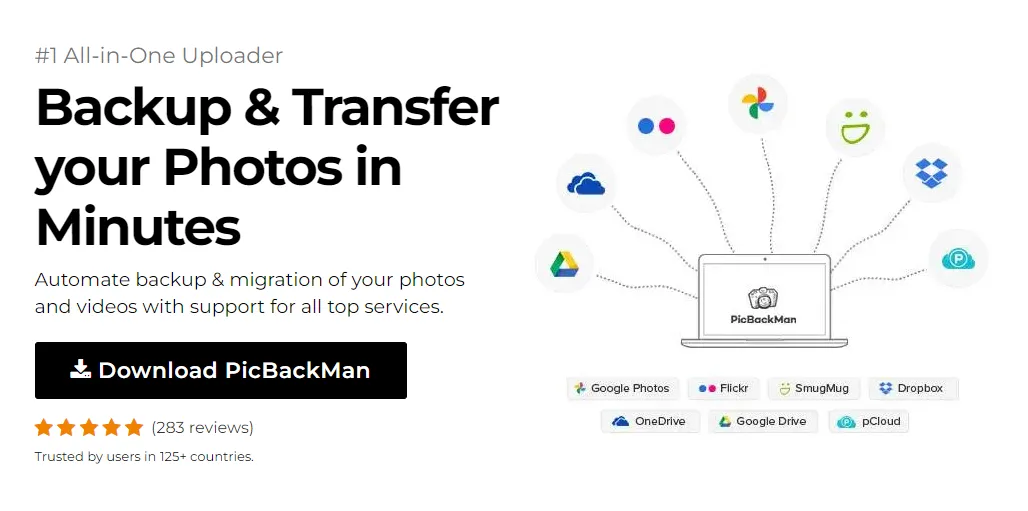
Why is it the #1 bulk uploader?
- Insanely fast!
- Maintains folder structure.
- 100% automated upload.
- Supports RAW files.
- Privacy default.
How can you get started?
Download PicBackMan and start free, then upgrade to annual or lifetime plan as per your needs. Join 100,000+ users who trust PicBackMan for keeping their precious memories safe in multiple online accounts.
“Your pictures are scattered. PicBackMan helps you bring order to your digital memories.”
5 Ways: Completely Transfer Google Photos to Another Account for Free


Need to move your precious memories from one Google Photos account to another? Whether you're switching personal accounts, consolidating photos, or helping a family member, transferring Google Photos doesn't have to be complicated or expensive. I'll walk you through five completely free methods to transfer your entire Google Photos library to another account.
Each method has its own advantages depending on your situation, internet speed, and the size of your photo collection. Let's dive into these practical solutions that anyone can use!
Why You Might Need to Transfer Google Photos
Before jumping into the methods, let's quickly look at common reasons why you might want to transfer your Google Photos:
- Switching from a work to a personal account
- Consolidating multiple accounts into one
- Helping parents or grandparents organize their photos
- Moving away from an old email address
- Creating a shared family photo collection
Whatever your reason, these free methods will help you transfer your photos without losing quality or spending money.
Method 1: Google Takeout + Manual Upload
This method uses Google's own data export tool to download your photos and then upload them to your new account.
Step-by-Step Instructions:
- Access Google Takeout: Go to takeout.google.com and sign in with the Google account containing your photos.
- Select Google Photos: Deselect all services, then scroll down and check only "Google Photos."
- Choose export settings: You can export all photo albums or select specific ones.
- Select file type and size: Choose .zip files (easier to handle) and select a size (I recommend 2GB for easier management).
- Choose delivery method: Select "Send download link via email."
- Create export: Click the button to start the export process.
- Wait for the export: Google will process your request, which may take hours or even days depending on your library size.
- Download the files: Once ready, download all the .zip files to your computer.
- Extract the files: Unzip all the downloaded files into one folder.
- Sign in to your new account: Open Google Photos with the account you want to transfer to.
- Upload to new account: Click "Upload" and select the extracted photos and videos.
Pros and Cons of Google Takeout Method
| Pros | Cons |
|---|---|
| Preserves original quality and metadata | Can be time-consuming for large libraries |
| Official Google tool | Requires sufficient hard drive space |
| Works for any size collection | Upload speed depends on your internet connection |
| Creates a backup on your computer | May need to manage multiple download files |
Method 2: Partner Sharing Feature
Google Photos offers a partner sharing feature that can help transfer photos between accounts.
How to Use Partner Sharing:
- Open Google Photos: Sign in with your source account.
- Access settings: Click on your profile picture in the top right, then select "Google Photos settings."
- Find partner sharing: Look for "Partner Sharing" in the menu and click on it.
- Set up sharing: Click "Get started" and enter the email address of your destination Google account.
- Choose what to share: Select "All photos" or set specific parameters.
- Send invitation: Click "Send invitation" to your other account.
- Accept invitation: Sign in to your destination account and accept the sharing invitation.
- Save shared photos: In the destination account, you can now see and save the shared photos to your library.
- Select and save all: To transfer everything, select all photos and click "Save to library."
Best For:
This method works well for smaller collections or ongoing transfers between personal accounts. It's particularly useful for couples or family members who want to maintain separate accounts but share photos.
Method 3: Shared Albums
Creating shared albums is another free way to transfer photos between Google accounts.
Step-by-Step Guide:
- Create albums: In your source account, organize photos into albums (you can create multiple albums with up to 20,000 photos each).
- Share the albums: For each album, click the share icon and select "Create link."
- Copy the link: Copy the sharing link for each album.
- Open in new account: Sign in to your destination account and paste the link in the browser.
- Save to library: Click on the three dots menu and select "Save all to library."
Tips for Shared Albums:
- Create multiple albums if you have more than 20,000 photos
- Use logical groupings like "Vacations," "Family," or by year
- Make sure to turn on sharing for each album
- Verify that all photos have been saved to the new account
Pros and Cons of Shared Albums Method
| Pros | Cons |
|---|---|
| No download required | 20,000 photo limit per album |
| Works directly in the browser | Requires organizing photos into albums |
| No hard drive space needed | May reduce photo quality slightly |
| Can be done in batches | Requires manual work for multiple albums |
Method 4: Google Drive as an Intermediary
Using Google Drive as a middle step can help transfer your photos effectively.
Detailed Instructions:
- Access Google Drive: Sign in to your source Google account and open Google Drive.
- Create a folder: Make a new folder to organize your photos (e.g., "Photos to Transfer").
- Upload photos: You can upload photos directly to this Drive folder, or...
- Connect to Google Photos: Go to drive.google.com/settings and check "Create a Google Photos folder."
- Find Google Photos in Drive: Look for the "Google Photos" folder in your Drive.
- Share the folder: Right-click on your photo folder and select "Share."
- Add your other account: Enter the email address of your destination Google account with Editor permissions.
- Accept sharing: Sign in to your destination account and accept the sharing invitation.
- Download to new account: In your destination account, select all photos in the shared folder, right-click, and select "Download."
- Upload to Google Photos: Go to photos.google.com in your destination account and upload the downloaded photos.
Important Notes:
This method works well for medium-sized collections but remember that both accounts will need sufficient Google Drive storage space. The photos count against the storage quota of both accounts during the transfer process.
Method 5: Desktop App Method
Using the Google Photos desktop backup app can be an efficient way to transfer photos.
Step-by-Step Process:
- Download photos: Use Google Takeout as described in Method 1 to download all your photos to your computer.
- Install Backup and Sync: Download and install "Google Backup and Sync" (or the newer "Google Drive for Desktop" app).
- Sign in to new account: Open the app and sign in with your destination Google account.
- Configure settings: In the app settings, select the folder containing your downloaded photos.
- Choose upload quality: Select either "Original quality" (counts against storage) or "Storage saver" (free unlimited for photos).
- Start backup: Click "Start" to begin uploading photos to your new Google Photos account.
- Monitor progress: The app will show upload progress. This may take time depending on your internet speed and collection size.
Comparison of All Methods
| Method | Best For | Speed | Difficulty | Storage Needed |
|---|---|---|---|---|
| Google Takeout + Upload | Complete transfers, maintaining quality | Slow | Medium | High |
| Partner Sharing | Personal accounts, ongoing sharing | Medium | Easy | None |
| Shared Albums | Organized collections | Medium | Easy | None |
| Google Drive Intermediary | Medium collections | Medium | Medium | Medium |
| Desktop App | Large collections, good internet | Fast | Medium | High |
Tips for a Successful Google Photos Transfer
Before You Start:
- Check storage space: Make sure your destination account has enough Google storage if you're transferring original quality photos.
- Sort and clean up: Consider deleting unwanted photos before transferring to save time and space.
- Check internet stability: Use a stable internet connection, preferably wired, for large transfers.
- Plan for time: Set aside enough time as transfers can take hours or days depending on your collection size.
During the Transfer:
- Keep track of progress: Make notes of what you've already transferred, especially if doing it in batches.
- Don't delete originals immediately: Wait until you've verified all photos have transferred successfully.
- Check for duplicates: Google Photos has duplicate detection, but it's good to verify yourself.
- Maintain organization: Try to preserve your album structure during the transfer.
After the Transfer:
- Verify all photos transferred: Compare photo counts between accounts.
- Check random samples: Look at photos from different time periods to ensure quality and metadata transferred correctly.
- Recreate albums if needed: Some methods may not preserve album organization.
- Update sharing settings: Re-share albums with friends or family from your new account if needed.
Quick Tip to ensure your videos never go missing
Videos are precious memories and all of us never want to lose them to hard disk crashes or missing drives. PicBackMan is the easiest and simplest way to keep your videos safely backed up in one or more online accounts.
Simply download PicBackMan (it's free!), register your account, connect to your online store and tell PicBackMan where your videos are - PicBackMan does the rest, automatically. It bulk uploads all videos and keeps looking for new ones and uploads those too. You don't have to ever touch it.
Troubleshooting Common Issues
Transfer Taking Too Long
If your transfer is extremely slow, try these solutions:
- Break the transfer into smaller batches
- Use a wired internet connection instead of Wi-Fi
- Try transferring during off-peak hours
- Close other bandwidth-heavy applications
Missing Photos After Transfer
If some photos didn't transfer properly:
- Check if they exceed file size or format limitations
- Look for them in the "Archive" section of Google Photos
- Try transferring the missing photos separately
- Verify they weren't already in your destination account (causing duplicates to be skipped)
Quality Issues
If your photos appear lower quality after transfer:
- Check if you selected "Storage saver" instead of "Original quality"
- Verify that the shared album settings maintained original quality
- Try the Google Takeout method which preserves original quality
Storage Space Problems
If you're running out of storage:
- Consider using "Storage saver" quality which doesn't count against your quota for photos (but does for videos)
- Transfer in batches, deleting successfully transferred files from the source to free up space
- Use the shared albums method which doesn't require extra storage during transfer
- Temporarily upgrade your Google One storage during the transfer process
Maintaining Your Photos After Transfer
Once you've successfully transferred your Google Photos to the new account, consider these practices to keep your photo library organized:
Regular Backups
Even though Google Photos is reliable, it's wise to maintain backups:
- Use Google Takeout once or twice a year to download a complete backup
- Consider a secondary cloud backup service for critical photos
- Keep important photos on an external hard drive as an offline backup
Organization Tips
Keep your new photo library tidy with these practices:
- Create themed albums for easy browsing
- Use Google Photos' search features to find specific photos
- Add descriptions to important photos to make them easier to find
- Create shared albums for family events to collect everyone's photos in one place
Privacy and Sharing
Manage who can see your photos:
- Review sharing settings for all your albums
- Use direct sharing with specific people rather than public links when possible
- Periodically review and revoke access for people who no longer need it
- Be cautious about enabling location data in your photos if privacy is a concern
Frequently Asked Questions
1. Will I lose photo quality when transferring between Google Photos accounts?
Not necessarily. If you use the Google Takeout method or the Desktop App with "Original quality" selected, your photos will maintain their original resolution and quality. However, using shared albums or selecting "Storage saver" during upload may slightly reduce quality to save space.
2. How long does it typically take to transfer a large Google Photos library?
The time varies greatly depending on your internet speed, collection size, and the method used. For libraries with thousands of photos, expect the process to take anywhere from several hours to a few days. The download and upload phases are the most time-consuming parts of the process.
3. Will transferring photos use up my Google storage quota?
It depends on your settings. Photos uploaded in "Original quality" count against your Google storage quota. Photos uploaded in "Storage saver" quality don't count against your quota (except for videos). During transfers using Google Drive as an intermediary, photos may temporarily count against both accounts' storage.
4. Can I transfer my Google Photos albums and their organization?
Most methods don't automatically preserve album organization. The shared albums method maintains some organization, but for other methods, you'll likely need to recreate your albums in the destination account. The Google Takeout method preserves album information in the downloaded files, but you'll still need to recreate albums after upload.
5. Is there a limit to how many photos I can transfer between Google accounts?
There's no specific limit to the total number of photos you can transfer. However, some methods have practical limitations: shared albums are limited to 20,000 photos per album, and very large transfers via Google Takeout may be split into multiple download files. With patience and batch processing, you can transfer libraries of any size.
Conclusion
Transferring your Google Photos to another account doesn't have to be complicated or expensive. With these five free methods, you can choose the approach that best fits your needs based on your collection size, internet speed, and technical comfort level.
The Google Takeout method offers the most complete transfer with original quality, while Partner Sharing and Shared Albums provide simpler approaches for smaller collections. Using Google Drive as an intermediary or the Desktop App method can be efficient for medium to large libraries.
Whichever method you choose, take your time and verify that all your precious memories have transferred correctly before deleting anything from your original account. With a bit of patience, you'll have all your photos safely moved to your new Google account, organized and ready to enjoy.






